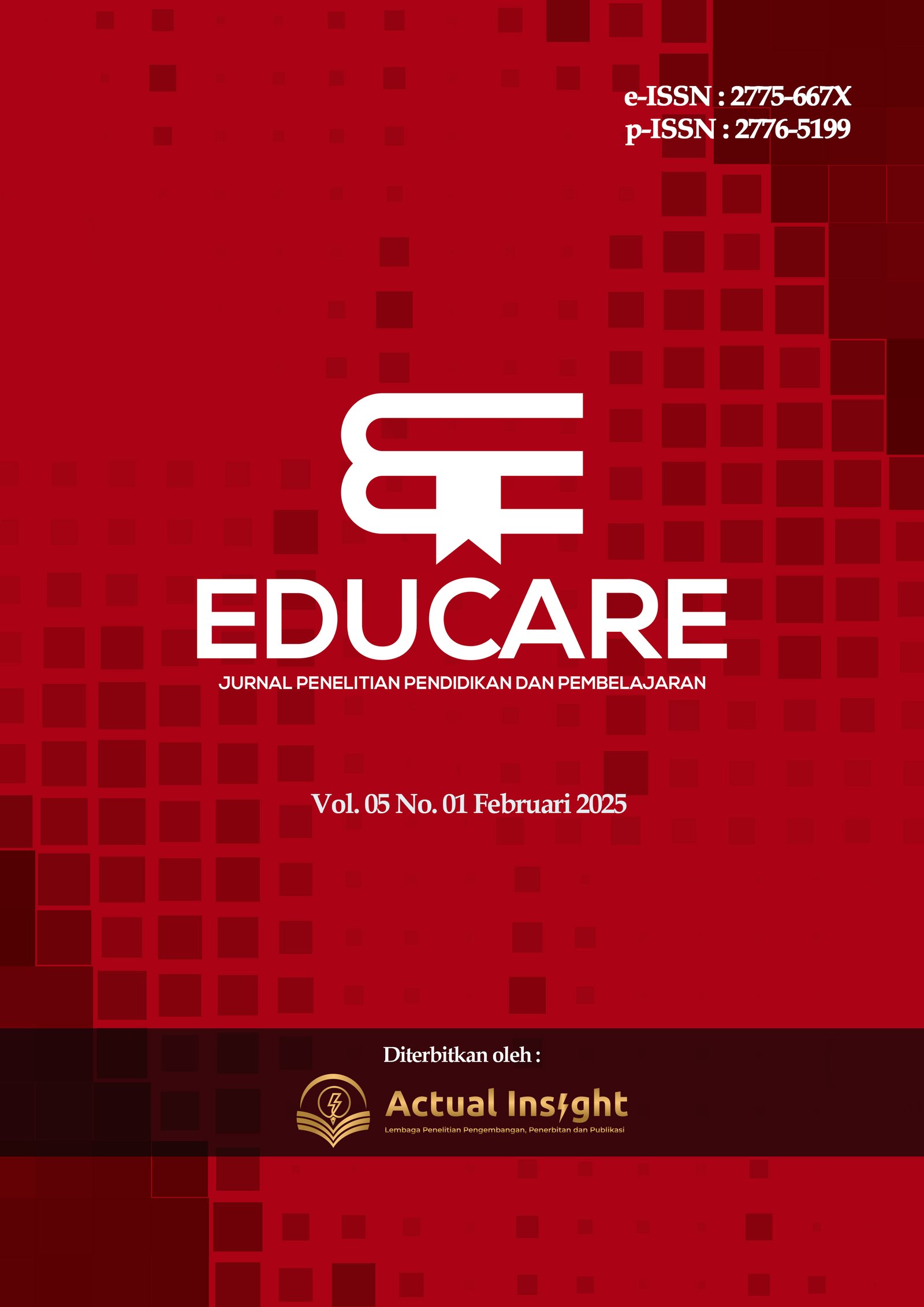Improving Mathematics Learning Outcomes Through Baamboozle Media with the Numbered Heads Together Model in Elementary School
DOI:
https://doi.org/10.56393/educare.v5i1.3276Keywords:
Baamboozle, Numbered Head Together, MathematicsAbstract
This study aims to improve the learning outcomes of mathematics students in grade IV of SDN Tanjungrejo 2 Malang through the application of Baamboozle interactive media combined with the Numbered Heads Together (NHT) learning model. The background of this research is based on the low mathematics learning outcomes, as shown by the average student score of 66.07 which is still below the Minimum Completeness Criteria (KKM) which is 75. This study uses the Kemmis and McTaggart model Class Action Research (PTK) method which is carried out in two cycles, each consisting of planning, implementation, observation, and reflection stages. The learning outcome data was obtained through an evaluation test at the end of each cycle and was analyzed in a quantitative descriptive manner by calculating the average score and percentage of learning completeness. The results showed that the average student score increased from 66.07 in the pre-cycle to 73.57 with 60.71% learning completeness in the first cycle, and increased again to 80.35 with 85.71% learning completeness in the second cycle. This finding proves that the application of Baamboozle interactive media combined with the Numbered Heads Together model is effective in improving the mathematics learning outcomes of grade IV students of SDN Tanjungrejo 2 Malang. The implications of this study show that the integration of interactive digital media with cooperative learning models can be an alternative to innovative, effective, and fun learning strategies in elementary schools.
Downloads
References
Adjie, N., Putri, S. U., & Dewi, F. (2021). Improvement of basic math skills through realistic mathematics education (RME) in early childhood. Journal of Obsession: Journal of Early Childhood Education, 6(3), 1650–1658. https://doi.org/10.31004/obsesi.v6i3.1832
Afdal, A., Handayani, E. S., & Rohaniah, R. (2024). Improving learning outcomes through a cooperative learning model in grade IIB elementary school students. PTK: Journal of Class Action, 4(2), 291–304. https://doi.org/10.53624/ptk.v4i2.355
Enrekang, U. M. (2022). Literature review: Interactive educational game media in mathematics learning. Journal of Mathematics and Science Education, 5(4), 4382–4390.
Hartanto, R. T., Hamidah, H., & Kusuma, J. W. (2024). The application of the game-based learning model with Baamboozle game quiz on the mathematical critical thinking skills of junior high school students. National Panel Discussion on Mathematics Education, 10, 45–53.
Ibrohim, I., Mansyur, S., Syah, M., Ruswandi, U., & Djati, S. G. (2020). Technology-based active learning strategies in improving mathematics learning outcomes. Journal of Educatio FKIP UNMA, 6(2), 548–560. https://doi.org/10.31949/educatio.v6i2.594
Ikhwandari, L. A., Hardjono, N., & Airlanda, G. S. (2019). Increasing students' motivation and mathematics learning outcomes with the numbered heads together (NHT) model. Journal of Basicedu, 3(4), 144–151. https://doi.org/10.31004/basicedu.v3i4.283
Indah Puspaningrum, D., Wijayanto, M. N., & Setiawaty, R. (2021). NHT model to improve learning outcomes of elementary school students (literature review). National Seminar of LPPM UMMAT, 1(1), 183–200.
Kasbolah. (2001). Classroom action research. Jakarta: Bumi Aksara.
Khaira Mardiah. (2024). The application of Baamboozle educational quiz in increasing motivation and learning outcomes in elementary students. Journal of Education Research, 12(2), 184–198.
Kusuma, E., & Fadiana, M. (2024). The use of Wordwall educational games to improve Indonesian learning outcomes for grade V elementary school students. Journal of Basic Science, 8(2), 1566–1573. https://doi.org/10.31004/basicedu.v8i2.7433
Kusyani, D., & Ray, S. A. (2023). The effectiveness of Baamboozle on the ability to understand North Sumatran folklore texts in grade VII junior high school students. Ghancaran: Journal of Indonesian Language and Literature Education, 5(3), 465–480.
Mariani, S. D., Larasati, D. A., Prasetya, S. P., & Stiawan, A. (2022). The effect of hybrid learning using Baamboozle media on the learning outcomes and interests of junior high school students. Journal of Social Studies Education Dialectics, 2(2), 206–216. https://doi.org/10.26740/jdpips.v2n2.48607
Nanditha, Y., Wirdati, W., & Kanus, O. (2023). The effect of the numbered heads together (NHT) type cooperative learning model on PAI learning outcomes. An-Nuha, 3(2), 228–239. https://doi.org/10.24036/annuha.v3i2.302
Nur, L., Siregar, K., Yana, S. P., Suryani, I., Haryati, D., Hutabarat, S., Nadira, D. A., et al. (2024). Mathematics learning in grade 3 elementary school at SDN 101765. Journal of Learning and Social Sciences, 2(1), 154–159. https://doi.org/10.61132/sadewa.v2i1.469
Sunny, V., Sundari, F. S., & Kurniasih, M. (2023). The application of the project-based learning model with concrete media to improve the learning outcomes of mathematics in class V E at SDN Police 1 Bogor City. Didactic: PGSD Scientific Journal STKIP Subang, 9(2), 1070–1079. https://doi.org/10.36989/didaktik.v9i2.788
Surya, Y. F. (2018). The application of the numbered head together model to improve social studies learning outcomes in grade IV of elementary school. Journal of Basicedu, 2(1), 136–145. https://doi.org/10.31004/basicedu.v2i1.34
Wiryana, R., & Alim, J. A. (2023). Mathematics learning problems in elementary school. Journal of Educational Progress, 2(3), 271–277. https://doi.org/10.33578/kpd.v2i3.187
Yasin, I. (2021). Cultural problems of improving the quality of education in Indonesia: A total quality management perspective. Ainara Journal: Journal of Research and PKM in the Field of Education, 2(3), 239–246. https://doi.org/10.54371/ainj.v2i3.87
Yeni, R. F. (2016). The use of the numbered head together (NHT) method in mathematics learning. Journal of Mathematics Research and Learning, 9(2), 263–267
Yestiani, D. K., & Zahwa, N. (2020). The role of teachers in learning in elementary school students. Journal of Fondatia, 4(1), 41–47. https://doi.org/10.36088/fondatia.v4i1.515



